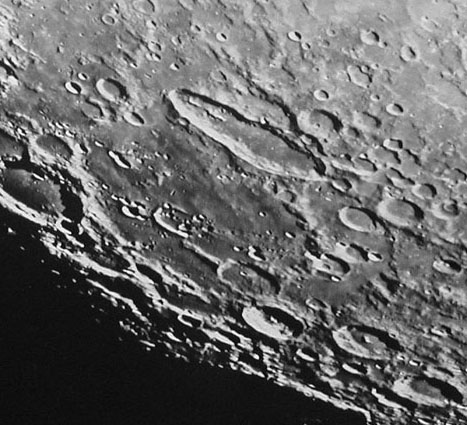Explanation:
How many times have you observed the weirdly elongated crater Schiller, or looked past Phocylides to find Wargentin, or beyond Zucchius to see Bailly? Did you ever notice the relatively smooth-surface between these other craters? Did you notice the horse-shoe shaped mountainous rim that arcs around from Schiller C to Segner, past Weigel B to Schiller S? Don't know where those craters are? Mouse over the image to find them. Did you notice the worn down scarp that stretches from Phocylides to Zucchius to Rost and finally Schiller? If you didn't notice those rim segments before don't feel bad - no one else did until the early 1960s when Bill Hartmann and Gerard Kuiper included this Basin near Schiller in their list of multi-ring impact basins. The mouseover image shows the two main rings of this basin and a dashed circle outlines a possible inner ring that seems to be a slight depression surrounded by an indistinct ridge. Thus, the Basin Near Schiller (or the Schiller-Zucchius Basin as the USGS renamed it) is a three ring basin with diameters of 335, 175 and 85 km. If you look at this area under full Moon conditions you will see that the smooth material isn't dark like a mare. But the smoothness and the mare-like ridges suggest that it is mare lavas veneered by light-hued ejecta. Multi-ring basins were the largest craters formed on the Moon - and some of the earliest. And now you know that they may be lurking undetected anywhere.
Related Links:
Lunar Orbiter IV View
|
Yanvar' Fevral' Mart Aprel' Mai Iyun' Iyul' Avgust Sentyabr' Oktyabr' Noyabr' Dekabr' |
|
Publikacii s klyuchevymi slovami:
Moon - Luna - Lunar Photo of the Day - LPOD
Publikacii so slovami: Moon - Luna - Lunar Photo of the Day - LPOD | |
Sm. takzhe:
Vse publikacii na tu zhe temu >> | |
